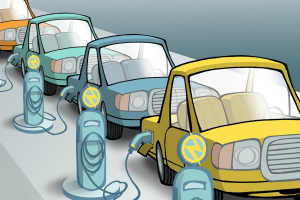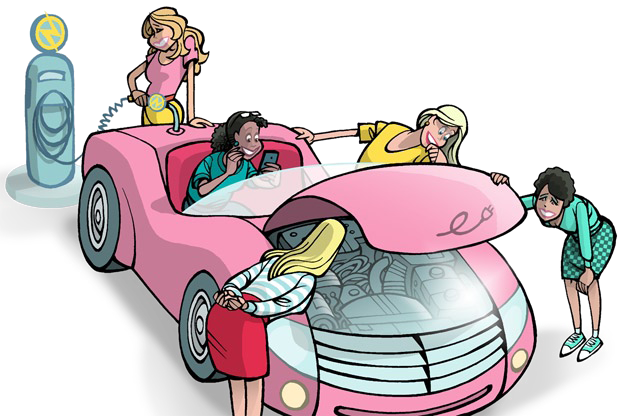How Electric Vehicles May Inspire New Expressions of America’s Car Culture
There’s no need to time-travel into the future to have an extraordinary experience driving an electric vehicle (EV). When the Tesla Model S P85D scored 103 on Consumer Reports‘ 100-point scale, it prompted the magazine’s editors to adjust the scale. “That this electric car accelerates from 0 to 60 mph in 3.5 seconds without an engine’s roar makes it frighteningly eerie in its silent velocity,” wrote the magazine’s reviewer, Mark Rechtin, adding: “Its significance as a breakthrough model that is pushing the boundaries of both performance and fuel-efficiency is dramatic.”
Joining Tesla in earning praise for the driving experience is General Motors’ Chevy Volt, which earned the top spot in Consumer Reports‘ owner satisfaction ratings and was named a top-five consumer favorite by Edmunds.com, an online car resource. Britta Gross, GM’s director of advanced vehicle commercialization policy, believes that the superior behind-the-wheel experience and economics of EVs will be common knowledge by 2050. “Once you experience the quiet smoothness, elegance, and spaceship-like driving of an electric vehicle, how in the world would you go back to a gas vehicle?” said Gross. “The low cost of driving on electricity reinforces that positive experience.”
Car Culture Goes Electric
The personal experience of a car extends well beyond acceleration and cornering. The United States’ distinct car culture is anchored in drivers’ emotional attachment to their vehicles. Cars transcend transportation. They can symbolize freedom or embody the owner’s personality. “I grew up in the 1970s, when guys would jack up their cars and buy special chrome Cragar wheels, or they’d buy vintage cars and customize them,” said Watson Collins, manager of research and business development at the utility Eversource Energy.
Can EVs find true love in such a culture? It’s unlikely that a culture of car clubs, car shows, television programs, and magazines will be able to ignore EVs, and it’s equally unlikely that automobile designers and manufacturers will pass up the chance to spark automotive infatuation. So how will individuality and affection be manifested? Collins offers some predictions. When large numbers of used EVs are available, Collins expects that car lovers will customize them to suit their personalities. “Instead of installing Cragars, people are going to figure out ways to soup-up their electric motors and put bigger batteries in their used cars,” he said.
Look for drivers to personalize new EVs as well, perhaps starting with the digital dashboard. “Like all things digital, dashboard customization might soon be possible through extra features offered by automakers or installation of third-party apps,” said Collins. “It wouldn’t be surprising to see options to have your dashboard look like your favorite NASCAR driver’s display, to limit when or how far a teen can drive a car, or to enable autonomous driving functions. Who would have thought 20 years ago that app stores would emerge for our cell phones? An app store for cars could be next.”
A New Kind of Car Club?
For serious electromechanics, there’s the opportunity to do what Andrew Kasznay did. Ten years ago, Kasznay—formerly a manager of assets and strategy at Eversource Energy—converted his 1980 Ford Pinto into an EV. “It took about six months and $7,000,” said Kasznay. “I installed 12 lead-acid batteries and a motor built by Advanced DC. This was well before electric vehicles were widely commercially available.”
While the Pinto may not be an obvious choice for such a conversion, there are growing numbers of individuals and clubs devoted to replacing pistons, cylinders, and camshafts with something smoother. Entrepreneurs can readily be found online, selling complete kits or individual components such as battery packs, chargers, controllers, and braking kits. Interested buyers can find everything from converted Porsches to pickup trucks. (One advertised truck addressed range anxiety by including a free tow bar.) Conversion how-to videos can be found on YouTube in the great variety typical of that channel.
Beyond car aficionados, EPRI Electric Transportation Program Manager Dan Bowermaster expects more everyday drivers to consider making the switch as the EV market scales up. “If your gas engine or transmission from a 1990s or 2000s car needs to be rebuilt, more people will convert to an electric car as prices decrease,” he said.
Artwork by Kirk Anderson




